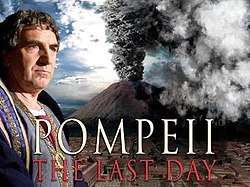Pompeii: The Last Day
| Pompeii: The Last day | |
|---|---|
 Title screenshot | |
| Genre | Docudrama |
| Written by | Edward Jones carter |
| Directed by | Peter Nicholson |
| Starring | |
| Narrated by | |
| Composer(s) | Ty Unwin |
| Country of origin | United Kingdom |
| Original language(s) | English |
| Production | |
| Executive producer(s) | Michael J. Mosley |
| Producer(s) | Ailsa Orr |
| Running time | 90 minutes |
| Distributor | BBC |
| Release | |
| Original network | BBC One |
| Original release | 20 October 2003 |
| Chronology | |
| Related shows | |
| External links | |
| Website | |
Pompeii: The Last Day is a 2003 dramatized documentary that tells of the eruption of Mount Vesuvius on August 24 79 AD. This eruption covered the Roman cities of Pompeii and Herculaneum in ash and pumice, killing everyone trapped between the volcano and the sea. The documentary, which portrays the different phases of the eruption, was directed by Peter Nicholson and written by Edward Canfor-Dumas.
Production
The film was directed and produced by the BBC in co-production with TLC.[1]
Awards
- Winner: sound supervisor Simon Farmer won the 2005 Primetime Emmy Award for Outstanding Sound Editing for Nonfiction Programming (Single or Multi-Camera) for this production.[2][3]
- Nominations: BAFTA 2004 nominations for Flaherty and RT Audience[3]
- Winner: BBC Factual Audience Award[4]
- Winner: RTS Education Award[4]
This was the highest rated specialist factual programme of the year with an audience of 10.3 million and a 40% share.[5]
Plot
The documentary tells the story of the eruption of Mount Vesuvius from the point of view of assorted inhabitants of Pompeii and Herculaneum whose names and occupations are known, including a local politician and his family, a fuller, his wife, and two gladiators. Historical characters include Pliny the Elder and his nephew Pliny the Younger.
It draws heavily on the eyewitness account of Pliny the Younger as well as historical research and recent discoveries in volcanology. Extensive CGI was used to recreate the effects of the eruption.
Death throes
Most of the people who were in Pompeii when the fourth pyroclastic surge hit died instantly or slowly suffocated to death.
- The death throes of those in the family of Julius Polybius are based upon the 1975 discovery of the skeleton of a heavily pregnant girl (Julia) surrounded by her family, in the actual House of Julius Polybius. Julia's husband, Sabinus, is shown to have most likely poisoned himself and presumably was the skeleton lying near the foot of the bed Julia's body was found on, along with the bones of her fetus.
- The death of Stephanus the Fuller is based upon a cast found of a man in the fetal position (the cast is locked up in an onsite warehouse for safekeeping).
- The death of Stephanus' wife, Fortunata, is based upon the discovery of the body of a rich bejeweled lady in the gladiator barracks, alongside those of gladiators.
- In Herculaneum, the death throes are much simpler, as most people were found during excavations either on the beach or inside the boat houses. Additionally, unlike Pompeii, when the pyroclastic surges hit Herculaneum, people there were instantly killed, whereas most Pompeians slowly suffocated, although some died instantly.
Cast
- Rachel Atkins - Plinia
- Omar Berdouni - Callistus
- Emily Canfor-Dumas - Slave girl
- Jim Carter - Polybius
- Rebecca Clarke - Fortunata
- Chrissie Cotterill - Epidia
- Jonathan Firth - Stephanus
- Martin Hodgson - Gaius - Pliny the Younger
- Leigh Jones - Sabinus
- Neji Nejah - Restitutus
- Tim Pigott-Smith - Pliny the Elder
- Chad Shepherd - Africanus
- Katherine Whitburn - Julia
- Robert Whitelock - Celadus
- Inika Leigh Wright - Hedone
- George Yiasoumi - Felix
- Tony Amendola - Pomponianus
Depiction
A computer-generated rendering of the eruption is inaccurate: the depictions of the Temple of Jupiter, facing the forum, and the Temple of Apollo, across the portico to the left, are inaccurate, and the depictions of the state of the porticoes around the forum are questionable, as they all appear intact during this recreation of the 79 eruption. In contrast, it is widely known that at least the Temples of Jupiter and Apollo had been destroyed 17 years before, during the 62 earthquake, and they had not been rebuilt by the time the city was finally destroyed in the 79 eruption.
References
External links
| Wikimedia Commons has media related to Pompeii: The Last Day. |
- Official Press Release at BBC Press Office
- Official Press Pack at BBC Press Office
- Pompeii: The Last Day on IMDb